Overview of Small Group Communication
Small group communication is defined as the interaction that occurs within groups of three to about 15 individuals. This size is considered optimal because it allows for a range of viewpoints, while still enabling each member to participate and be heard. The group size is small enough for everyone to engage directly with one another, yet large enough to bring diverse skills and perspectives to the group.
Small group communication can occur in various settings such as a workplace team, a committee, a study group, or a sports team. These groups often come together with a common goal or purpose, whether it’s to solve a problem, make a decision, or create something. The nature and quality of communication within these groups can significantly impact the group’s effectiveness and the satisfaction of its members.
In small group communication, members can interact in various ways, such as face-to-face meetings, conference calls, or through digital platforms. Each member’s communication skills, such as their ability to listen, give and receive feedback, and manage conflicts, are crucial in facilitating effective group communication.
It’s important to note that small group communication is not just about talking and exchanging information. It’s also about building relationships, establishing norms, negotiating roles, and influencing one another. Moreover, power dynamics, group stages of development, and cultural factors can also play a significant role in shaping communication within a small group.
In summary, small group communication is a complex, dynamic process that involves much more than the simple transmission of information. It’s about negotiating meanings, managing relationships, and working together towards common goals. It’s an integral part of our personal and professional lives, and mastering it can significantly enhance our effectiveness in various group settings.
Understanding the Basics of Group Communication
Defining Small Group Communication
Small group communication plays a critical role in both personal and professional contexts, and its importance can’t be overstated. Here’s why:
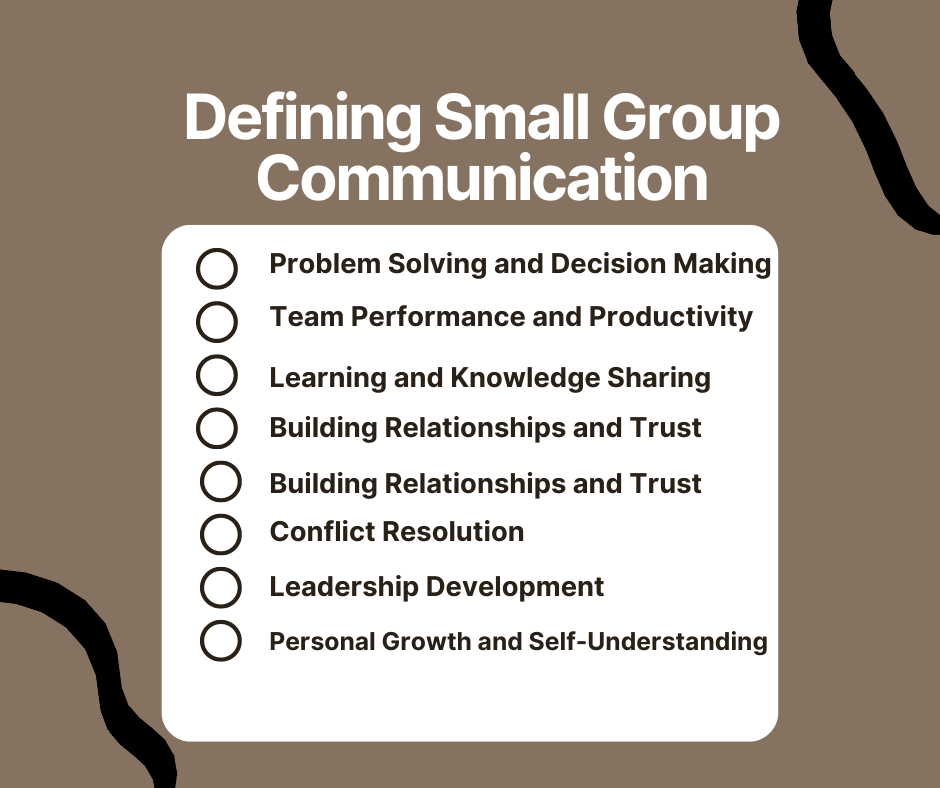
Problem Solving and Decision Making: Small groups often come together to make decisions or solve problems. They bring together diverse perspectives, knowledge, and skills, enabling them to tackle complex issues that may be beyond the capabilities of an individual.
Team Performance and Productivity: Effective communication within a small group can enhance team performance, increase productivity, and drive innovation. It facilitates coordination, helps in setting and achieving goals, and fosters a cooperative and collaborative work environment.
Learning and Knowledge Sharing: Small group communication also plays a crucial role in learning. Whether in a classroom discussion group, a workplace training session, or a study group, interacting with others can enhance understanding, encourage critical thinking, and facilitate knowledge sharing.
Building Relationships and Trust: Communication within a small group is not just about task completion; it also helps in building relationships. Regular and effective communication helps in developing trust, understanding, and camaraderie among group members.
Conflict Resolution: Differences of opinion are common in small groups. Effective communication helps in resolving conflicts, reconciling differences, and ensuring that all voices are heard. It supports the expression of diverse viewpoints and facilitates negotiation and compromise.
Leadership Development: Small group communication also provides opportunities for leadership development. Leading a group involves a range of communication skills, including facilitating discussions, listening actively, providing feedback, and motivating members.
Personal Growth and Self-Understanding: Participating in small group communication can lead to personal growth and increased self-understanding. Interacting with others provides feedback about our ideas and behavior and gives us opportunities to see things from different perspectives.
Challenges in Small Group Communication
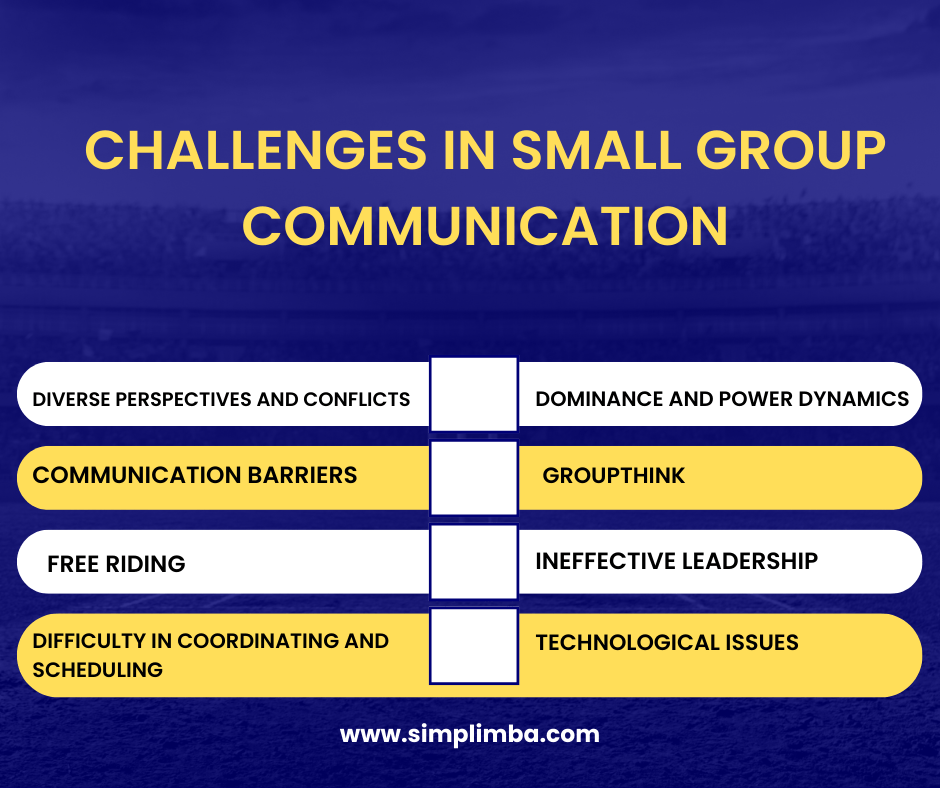
Diverse Perspectives and Conflicts: In small groups, members often come from diverse backgrounds and have different viewpoints. While this diversity can lead to innovative ideas, it can also cause conflicts, misunderstanding, and tension within the group.
Dominance and Power Dynamics: Power dynamics can impact group communication significantly. Some members may try to dominate conversations, while others may be reluctant to share their ideas due to fear of criticism or rejection.
Communication Barriers: Cultural, language, and personal barriers can hinder effective communication. Misunderstandings or misconceptions can arise if group members do not share the same language proficiency or understand each other’s cultural cues.
Groupthink: This is a situation where the desire for harmony and consensus within the group leads to poor decision-making. It happens when group members suppress dissenting viewpoints, leading to a lack of critical thinking and evaluation.
Free Riding: Also known as social loafing, this is a situation where some group members rely on others to do the work. It can lead to resentment and conflict within the group and can impact the overall productivity and effectiveness of the group.
Ineffective Leadership: Leadership plays a crucial role in small group communication. Ineffective leadership can result in lack of direction, poor decision-making, and low group morale.
Difficulty in Coordinating and Scheduling: In our increasingly busy and connected world, finding a common time and place for all group members to meet and communicate can be challenging. This problem can be particularly acute in virtual teams, where members may be spread across different time zones.
Technological Issues: In today’s digital age, much of our group communication happens through digital platforms. Issues like unstable internet connection, poor audio or video quality, and unfamiliarity with digital tools can hamper effective group communication.
Brief Biography of Aubrey Fisher
Aubrey Fisher and His Contribution to Communication Studies
Aubrey Fisher was a well-respected professor and scholar in the field of communication studies. His research focused primarily on small group communication and group decision-making processes.
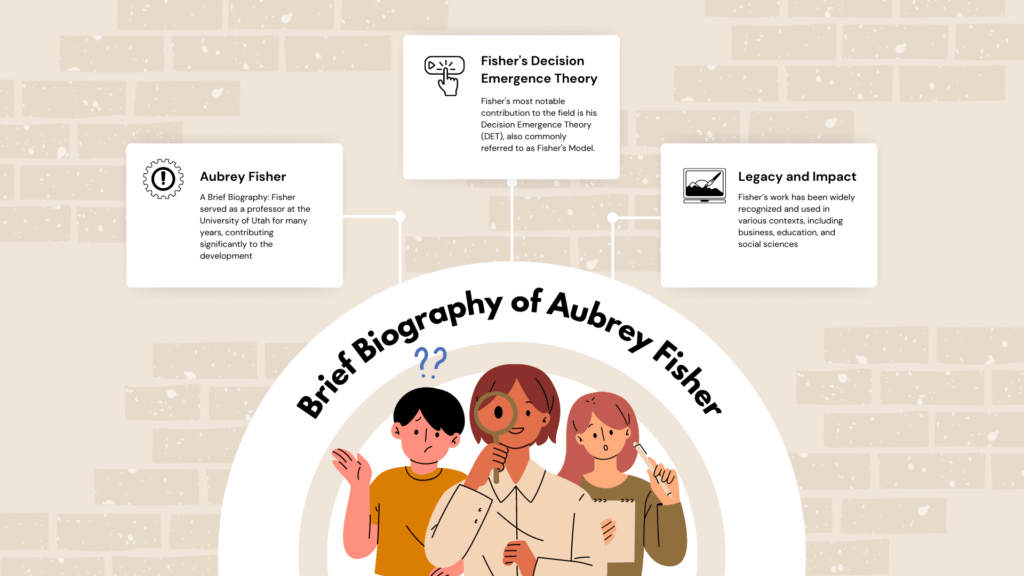
- Aubrey Fisher: A Brief Biography: Fisher served as a professor at the University of Utah for many years, contributing significantly to the development and reputation of their communication department. His extensive research and teaching influenced many students and future scholars in the field.
- Fisher’s Decision Emergence Theory: Fisher’s most notable contribution to the field is his Decision Emergence Theory (DET), also commonly referred to as Fisher’s Model. This theory provides a framework for understanding the communication processes and stages that small groups go through when making decisions or solving problems.
- Legacy and Impact: Fisher’s work has been widely recognized and used in various contexts, including business, education, and social sciences, to understand and improve small group communication dynamics. His model remains a crucial part of the study and application of small group communication.
Unraveling Fisher’s Model: An Overview
Fisher’s Model: The Four Phases
Fisher’s Model suggests that small groups go through four distinct phases when making decisions or solving problems:
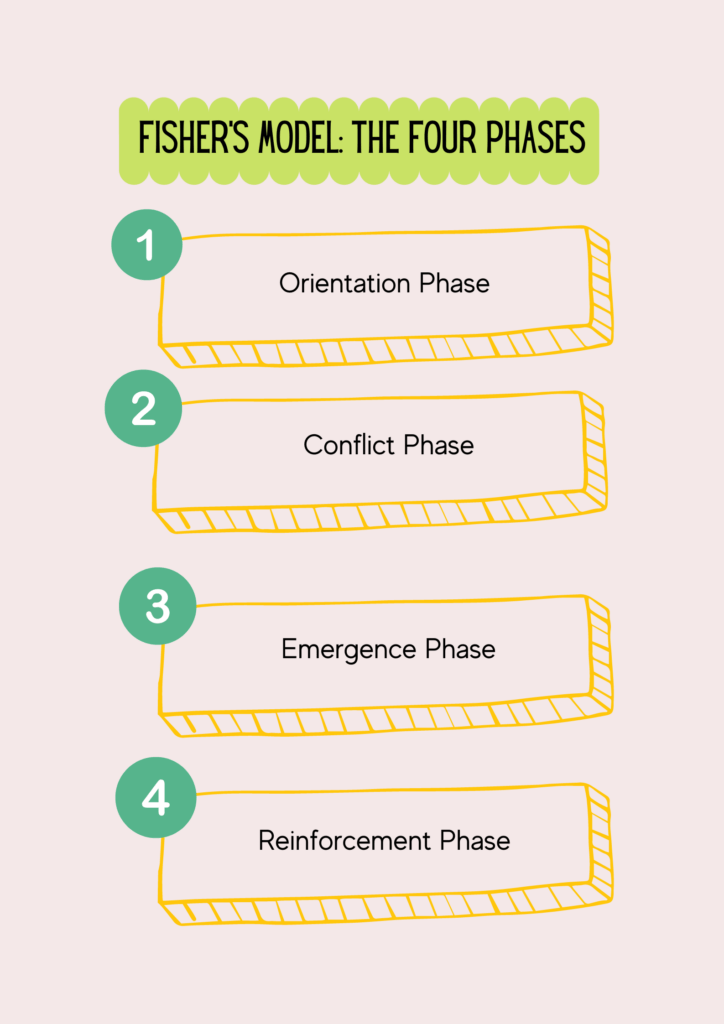
Orientation Phase: In the orientation phase, group members become acquainted with each other and the task at hand. This phase is characterized by tentative interactions as individuals seek to understand the group’s purpose, establish relationships, and form initial impressions. Communication is often polite and non-committal.
Conflict Phase: As the group delves deeper into the task, different ideas, opinions, and approaches emerge, leading to disagreements or conflicts. In this phase, group members engage in debates and arguments as they explore different perspectives and contest each other’s views. Communication is more assertive and can sometimes be confrontational.
Emergence Phase: After going through the conflict, the group begins to converge towards a decision or solution. Group members start to find common ground, and a sense of agreement starts to emerge. Communication during this phase is often collaborative and consensus-building.
Reinforcement Phase: In this final phase, the group’s decision or solution is solidified and reinforced through positive reactions and affirmations. Group members express satisfaction with the decision and with each other, reinforcing the group’s cohesion and unity. Communication is positive and affirming.
Understanding the Role of Communication in Each Phase
Communication plays a significant role in each of these phases:
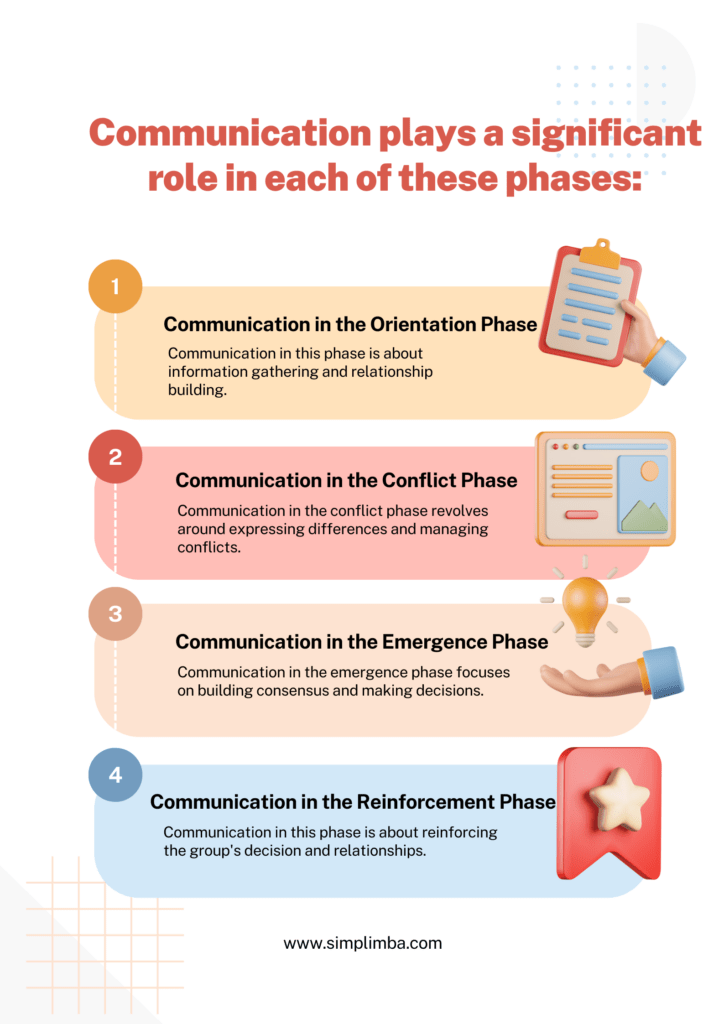
Communication in the Orientation Phase: Communication in this phase is about information gathering and relationship building. It involves asking questions, sharing information, expressing preferences, and offering personal information to establish rapport.
Communication in the Conflict Phase: Communication in the conflict phase revolves around expressing differences and managing conflicts. It involves advocating for one’s views, questioning and challenging others’ ideas, providing evidence or arguments, and using conflict resolution skills.
Communication in the Emergence Phase: Communication in the emergence phase focuses on building consensus and making decisions. It involves negotiating, seeking common ground, proposing solutions, and discussing the pros and cons of different options.
Communication in the Reinforcement Phase: Communication in this phase is about reinforcing the group’s decision and relationships. It involves expressing agreement, providing positive feedback, celebrating the group’s accomplishments, and affirming the value of the group and its members.
Fisher’s Model in Practice: Real-world Examples
Fisher’s Model is a versatile tool that can be used to understand and enhance group communication and decision-making in a variety of contexts. Let’s look at how it can be applied in corporate settings, educational groups, and informal small groups.
Applying Fisher’s Model in Corporate Settings
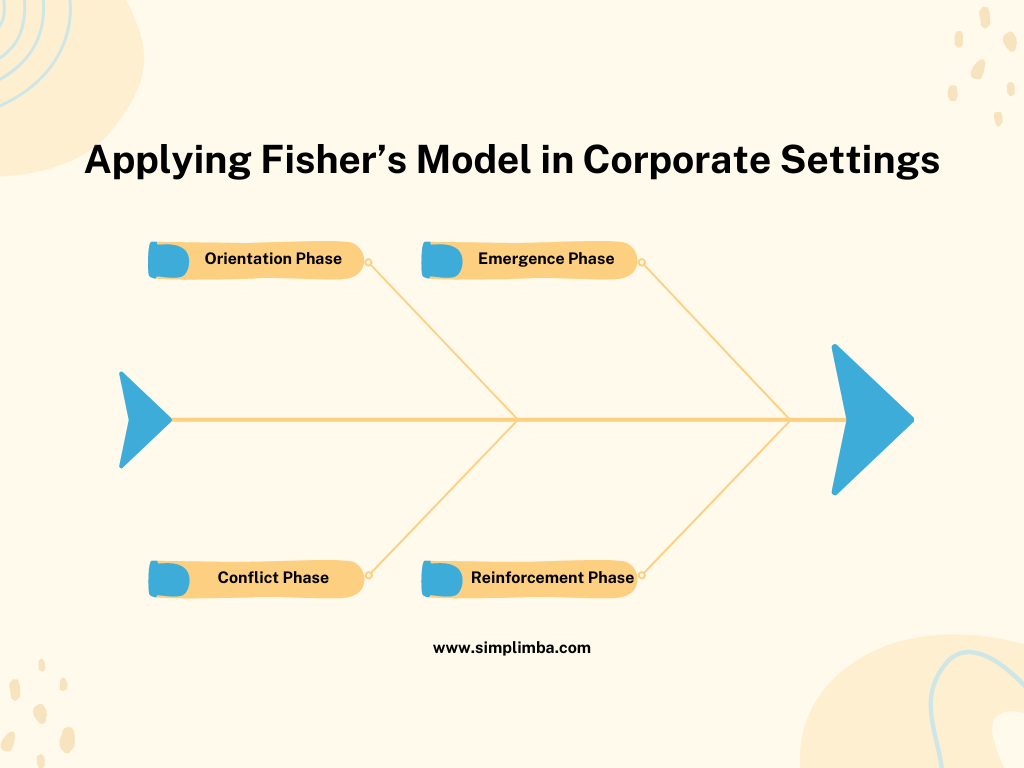
- Orientation Phase: In a new project team, members meet for the first time to discuss the project objectives and their roles. They might engage in small talk to build rapport and understand each other’s backgrounds and skills.
- Conflict Phase: As the team starts to plan the project, members might have different ideas about the best approach. Debates might ensue over project timelines, resource allocation, or technical solutions.
- Emergence Phase: After much discussion and negotiation, the team begins to converge towards a shared plan. Members find common ground, agree on a course of action, and decide on responsibilities.
- Reinforcement Phase: The agreed-upon plan is affirmed in a project proposal, and team members express their commitment to the plan and their confidence in the team.
Fisher’s Model in Educational Groups
- Orientation Phase: At the start of a group assignment, students come together to understand the assignment requirements and get to know each other.
- Conflict Phase: Disagreements may arise over the assignment’s interpretation, the division of labor, or the approach to the task.
- Emergence Phase: The group eventually settles on an approach, assigns tasks, and agrees on a timeline for completion.
- Reinforcement Phase: The group’s decisions are affirmed, and members express their readiness to work together to complete the assignment.
Use of Fisher’s Model in Informal Small Groups
- Orientation Phase: A group of friends decides to plan a trip together. Initially, they discuss their preferences, availability, and budget constraints.
- Conflict Phase: Disagreements might occur over the choice of destination, the travel dates, or the budget.
- Emergence Phase: After discussing various options, the friends agree on a destination, dates, and budget that work for everyone.
- Reinforcement Phase: The group’s decisions are solidified as they start booking tickets and accommodations, and they express excitement about the upcoming trip.
Comparing Fisher’s Model with Other Small Group Communication Models
| Aspect | Fisher’s Model | Tuckman’s Model | Poole’s Model |
| Primary Focus | Fisher’s Model is primarily focused on the communication process within small groups and how it evolves through four sequential phases in the decision-making process: Orientation, Conflict, Emergence, and Reinforcement. | Tuckman’s model is concerned with the group’s overall development over time and comprises five stages: Forming, Storming, Norming, Performing, and Adjourning. | Poole’s Multiple Sequence Model takes into account the non-linear and complex nature of group decision-making. It suggests that groups follow multiple tracks or sequences that are interdependent: task progress, relational, and topical focus sequences. |
| Role of Conflict | Conflict is seen as a necessary part of the group decision-making process, appearing primarily in the second phase of the model. | Conflict arises in the ‘Storming’ stage, where disagreements and power struggles may emerge. It’s seen as a natural stage in the development of a group. | Conflict is viewed as an element that can occur at any time and can shift a group between different sequences or within a sequence. |
| Application | Fisher’s Model is applied to small group communication with a particular focus on how groups arrive at decisions. | Tuckman’s model is applicable in various settings where a group evolves over time, including corporate, educational, and therapeutic environments. | Poole’s Model is used in settings where decision-making is complex and non-linear, such as in high-stakes corporate decisions or policy-making groups. |
| Flexibility | Fisher’s Model is largely sequential, assuming groups progress through each phase in order. | While Tuckman’s stages are sequential, he acknowledges that groups may revisit stages as necessary. | Poole’s model offers high flexibility, acknowledging that groups may move in various directions between sequences and within sequences. |
| Closure | The final phase, Reinforcement, involves solidifying and affirming the group’s decision. | The final stage, Adjourning, focuses on the conclusion of the group’s task and the potential dissolution of the group. | Closure in Poole’s model is less definitive. Depending on the sequence and the progress within each sequence, the group may reach a decision, or they may cycle back to previous issues or tasks. |
Criticisms and Limitations of Fisher’s Model
While Fisher’s Model is widely recognized for its insights into small group communication, it is not without its criticisms and limitations:
Sequentiality: Fisher’s Model assumes that groups move through the four phases in a sequential and linear manner. However, in practice, group communication and decision-making can often be non-linear and iterative, with groups moving back and forth between different stages based on new information, changing circumstances, or conflicts.
Conflict Representation: While the model acknowledges the role of conflict in group decision-making, it assumes that conflict primarily occurs in one phase (the conflict phase) and then gets resolved. In reality, conflicts can arise at any point in the group process and may not always be fully resolved.
Role of Individual Differences: Fisher’s Model doesn’t fully account for the impact of individual differences on group communication. Factors like personality traits, communication styles, cultural backgrounds, power dynamics, and interpersonal relationships can significantly influence the group process and may not be adequately captured by the model.
Lack of Emphasis on External Factors: The model doesn’t explicitly address the influence of external factors on group communication and decision-making. Factors such as organizational culture, leadership, and environmental pressures can significantly impact the group’s process and outcomes.
Limited Applicability: While the model is applicable in a variety of small group contexts, its relevance and accuracy may be limited in larger groups or complex organizational settings, where decision-making processes are more complicated and involve multiple sub-groups and levels.
Future Directions for Small Group Communication Studies
The field of small group communication continues to evolve, with new research directions emerging based on changes in our society, technology, and understanding of human behavior. Here are some potential future directions for the field:
Digital and Virtual Group Communication: With the rise of remote work and virtual teams, there’s a growing need to understand the dynamics of small group communication in digital spaces. Future research might explore how communication behaviors, norms, and dynamics differ in virtual groups and how to enhance virtual group communication and collaboration.
Cross-cultural and Diverse Group Communication: As our society becomes more diverse and globally interconnected, understanding how to navigate cultural differences in small group communication is increasingly important. Future studies might investigate how cultural values, norms, and practices influence group communication and decision-making and how to foster effective communication in diverse groups.
Artificial Intelligence in Group Communication: The incorporation of AI in group tasks and decision-making processes is a fascinating area for future research. This includes studying how AI might influence group dynamics, roles, and communication processes, and how groups can effectively interact with AI tools.
Influence of Social Media on Group Communication: Social media platforms have become common tools for small group communication. Future research could explore the impact of social media on group dynamics, such as how it affects group cohesion, conflict, decision-making, and other aspects of group communication.
Group Communication and Mental Health: As awareness of mental health issues grows, there is increasing interest in understanding the role of group communication in supporting mental well-being. This might involve studying how communication in therapy groups, support groups, or even work groups can contribute to or detract from individuals’ mental health.
Sustainable and Environmental Group Decision-Making: In the face of global environmental challenges, understanding how groups make decisions related to sustainability and environmental conservation is becoming more crucial. Research might focus on how groups communicate and make decisions about environmental policies, sustainable practices, or climate change mitigation strategies
Samrat is a Delhi-based MBA from the Indian Institute of Management. He is a Strategy, AI, and Marketing Enthusiast and passionately writes about core and emerging topics in Management studies. Reach out to his LinkedIn for a discussion or follow his Quora Page

